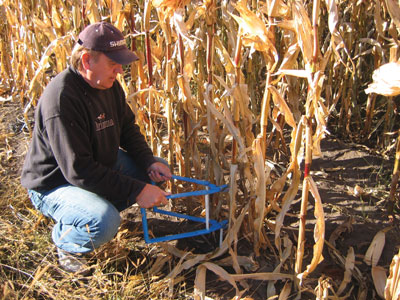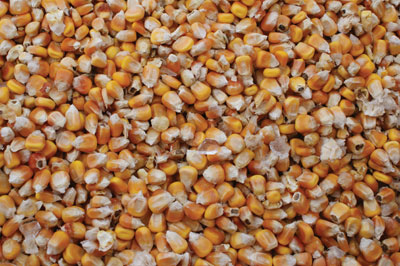
Features
Agronomy
Fertility and Nutrients
Cornstalk nitrate test valid in Manitoba
Curious corn growers, who have wondered how much nitrogen (N) they really need, can now put a little science to the question and get a pretty reliable answer, says John Heard, provincial soil fertility specialist, from Carman, Manitoba.
February 24, 2010 By John Dietz
A new corn test for late October or November may provide a “rear view mirror” on the crop’s nitrogen supply.
Curious corn growers, who have wondered how much nitrogen (N) they really need, can now put a little science to the question and get a pretty reliable answer, says John Heard, provincial soil fertility specialist, from Carman, Manitoba. Like a soil test, a tissue sample or protein report for wheat, the cornstalk nitrate test indicates whether the past crop had enough nitrogen, too little or too much. The test may be particularly useful for growers who deal with manure or corn grown after alfalfa. It can also help those who want to evaluate their nitrogen fertility program.

|
| Roy Heinrichs, below, did the corn yield sampling and cornstalk nitrate sampling for the 2008 Manitoba Corn Growers Association high yield competition. (Photo courtesy of MAFRI.) Advertisement
|
Cornstalks serve the developing grain as N reservoirs, Heard explains. The level in the stalk varies with crop needs and the growing season. The window for taking cornstalk samples is about a month, starting in the fall when the corn stops pushing nutrients into kernels. Because the nitrate is soluble, fall weathering gradually leaches it out and reduces the reliability of test results. “Nitrogen levels in the stem tend to move in and out of the stem based on whether there’s a surplus or a deficiency. If N supply is short, more tends to be drawn out of the stem and into the grain.”
Much can be learned from the residual in the stalk in the period following physiologic maturity. Corn mobilizes many carbohydrates and nutrients in the leaves and stalk to build the grain. If it has more than enough N, the excess remains stored in the lower portion of the stalk; if it needs more N for the kernels, it depletes the reservoir in the stalk.
Essentially, the ‘reservoir’ has a lower and upper threshold. If it tests below the lower threshold, then that crop did not have enough nitrogen to reach its full yield potential. Conversely, if the nitrate level is above the upper threshold, it means nitrate was supplied to the crop at a level beyond what was required for full yield potential or that another factor like drought limited the yield, Heard says.
Test development
Tissue testing for cornstalk nitrate was developed at Iowa State University in the 1990s. Researchers in several states gradually developed benchmark values to tell farmers whether they were under- or over-fertilizing, or just enough. It now is widely adopted in the American Midwest, Heard says.

|
|
| The brownish ends on these fresh-harvest corn kernels indicate food has stopped translocating to the seed and the crop is physiologically mature, after which only dry down is needed for harvest. Photo by John Dietz. |
Recently, the Manitoba Corn Growers Association began testing N rates and sources. An added benefit determined whether the stalk test could be valid for Southern Manitoba corn growers. Three studies were conducted between 2005 and 2008. Heard summarized the results in 2009.
Study 1 revealed the relation between stalk nitrate and yield. Yields were restricted where testing showed the N residual in the stalk was less than roughly 600 parts per million. Where the crop had an ‘optimal’ yield, unrestricted by N availability, the level in the stalk was between 600 and about 2000 ppm. Adding additional fertilizer could push the stalk nitrate higher, but yields did not increase.
Study 2 was a 2008 ‘test drive’ in three fields with a fertilizer treatment on top of a recent manure treatment. Heavy weed competition set back one field. However, without any further N application, the other two fields had sufficient N in the soil to produce stalk nitrate levels at around 2000 ppm. Up to 75 lbs per acre of additionally applied N did virtually nothing for the yield but increased stalk N.
Study 3 tested stalk nitrate levels in 46 corn fields that were entered in the 2008 Manitoba Corn Growers Association yield contest, as well as an additional 12 corn fields treated with manure in a separate MAFRI study. Two-thirds had excessive stalk-N, with more than 2000 ppm. The optimal range was found in 17 fields or about 30 percent. Three fields were low to marginal, with less than about 750 ppm.
Heard says, “These fields may not be representative. Corn yield competitors probably selected their best fertilized fields to enter. Nevertheless, it may indicate many growers are supplying N in excess of that needed to optimize yield.”
Field audit
Doing a cornstalk nitrate test amounts to doing a field audit and is well suited to several groups of corn growers, Heard says. It can aid growers who:
- plant corn into land treated with manure or into land that was in forage;
- have confusing signals like low yields in well-fertilized fields;
- want to shave their fertilizer input rates for corn.
“It provides some fairly strong advice for people on how they may want to adjust their systems,” he says.
American corn growers use the cornstalk test to help them understand why one area of a field is doing better than another area. For example, N losses due to heavy spring rainfall sometimes are revealed by a stalk test that indicates insufficient N. Those results point to a solution like side-dressing in June with N rather than doing a single all-inclusive spring treatment.
Farmers who do their own soil test probably also could do the cornstalk nitrate test, Heard says. It is also a natural service option for people who do soil testing or work as cropping consultants. “The real hope is that it will help people with N rates and timing. This is a tool that will give you an indication of how to adjust N next year. It looks in the rear-view mirror and says you were low, high or just right.”
The common reaction, for corn growers viewing test results last February, was: ‘I can use that. Now I can ease my foot off the pedal.’
| Testing method
When the nutrient mobilization to kernels is complete, a black layer starts to form at the bottom of the kernel. Sampling should be done within three weeks of that black layer formation. An eight-inch sample of stalk is needed for each sample, taken at a standard height, six inches to 14 inches above the soil surface. Samples should be cut from 10 to 20 plants, and submitted to a lab for analysis. “The easiest way to do this is to wait until it’s harvested and maybe do it at the same time as you do soil samples,” Heard says. “I’d cut out 15 or 20 samples with a pair of sheers from what I think is typical of the field. For contrast, I might compare this ‘typical’ area to one that’s not doing so well or to an area where I did put on more manure, just so I can figure out what my normal range might be.” The Agvise Laboratories’ website, www.agvise.com/tech_art/cornstalk.php, recommends collecting samples “as early as one to three weeks after black layer stage through immediately after harvest. If sampling after harvest, collect the sample as soon as possible…because nitrates can be leached out of the cornstalk by rainfall.” Testing labs operating in corn growing areas typically offer the service, so check with a local agronomist or lab. |